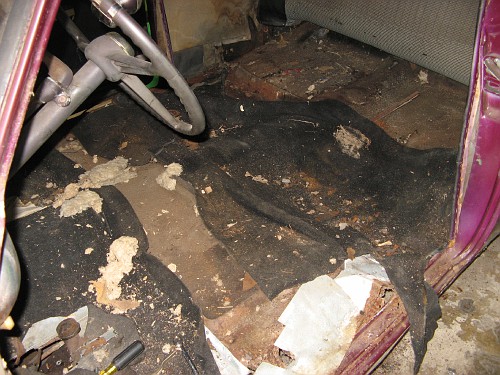When a car has rusted this bad underneath, you have to be ready for the possibility that things have moved, or that they may move when you start cutting out what is left. When the car has rusted this bad and lost a front wheel (running over it in the process)- even more likely. Working in our favor (about freaking time something does!) is the fact that this car is a sedan, not a hardtop. The fact that it has a "B" pillar helps strengthen the body.
So, before we begin cutting, we need to brace everything up solidly. But, before that- we need to make sure that the cowl and B Pillar are correctly oriented to one another. There will never be a better time to correct this than right now.
So, we start by taking a lot of measurements, and as luck has it, they look pretty good. Things look pretty square. However, if we consider the alignment of the doors NOW, it may make things a LOT easier down the road. The passenger door was aligned pretty close when I got the car, and it didn't take long to get it lined up perfectly. So, we used a bit of 1" square tube just to ensure things stay put.
45 degree braces from the rear inner quatrter panel to the floor, and from the front door jamb to the trans tunnel. I tied them together with another piece of 1" tube.
The driver's side is what worried me. The tire that came off hit the back of the fender near the cowl, and the fender was so weak that it didn't take much of the hit. After that hit, the car rolled over it, and the weak rocker got an upward bend to it, and actually broke loose at the front. When I put the new door on it last Summer, I never was able to get it lined up very well. It always sat a bit too far to the rear, even with all of the adjustment taken out.
That front fender that I can't use after all still has a purpose. I put it on temporarily to check the door to fender gap, and it showed an excessive gap.
The primer on the door and the camera flash almost hide it, but the gap is almost 3/8"
I got lucky again- I loosened the bolt holding the cowl to the frame under the door jamb at the front, and it sprang forward a slight bit. I still needed to slot the hinge mounting holes slightly (less than 1/8"), but after a couple of test fittings, the door was lining up like a champ!
So, the next step is to brace up the driver's side the way we braced the passenger's side.
Now, we're ready to start remaking the bottom of the car. But first- CAR SHOW BREAK! My absolute favorite car show in Indy every year is the Road Rocket Rumble. It's a Friday-Saturday show, and I like going both days. Great cars and better people! It's a pretty deep resource for ideas and inspiration, and this year was no different.
This '53 Lincoln was SWEET, And it had the lake pipes done the way I want to do mine. I'd never seen it done before, but in my mind, it looks awesome. This car proved that it looks as good in reality as it does in my head.
Slick and sweet!
This picture was shot last month in Louisvile, but it was at the Rumble, too. This car is inspiring, to say the least. Many of the things he did are on the schedule for our car. There is not a single unmodified body panel on this car.
Back home after the second day of inspiration, it's time to start making some new floors.
To start, these will be our most important tools
Besides these, but they're important tools in all of the jobs.
The butcher paper is for making patterns. Once we trace out the pattern on the paper, we cut it out, and transfer it to the metal. If you try eyeballing this sort of thing, you're going to waste a LOT of sheetmetal!
Getting ready to transfer from pattern to metal
Transferring (note: here's a really good sales idea for the people who make Sharpies- offer them with flavored caps.)
Cutting. The Harbor Fright unishear surprised me with how well it cuts this thick stuff.
And the first piece is cut! A couple whacks with the slapper to flatten it back out, a couple of bends, and it will be ready to install!
I mentioned that the metal I'm using is thick. It's 16 gauge. We all know that older cars used thicker metal than today's cars do. In truth, the body of this car was all 18 gauge originally. On the bottom of the car, I'm going with the slightly thicker metal to add an extra level of strength. Over-engineering is one of my trademarks professionally, and I'm not going to stop doing it on my car. It's a bit harder to work with, but I want the car to outlive me, and this seems like better insurance to that end.
It's almost time to start showing some serious automotive cancer surgery!









